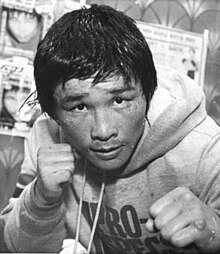
On thisday November 13 1982 Ray Mancini defeats Duk Koo Kim in a boxing match held in Las Vegas. Kim's subsequent death leads to significant changes in the sport. Kim Duk-Koo (January 8, 1955 – November 18, 1982) was a South Korean boxer who died following a world championship boxing match against Ray Mancini. His death sparked a number of reforms in the sport aimed to better protect the health of fighters, including reducing the number of rounds in championship bouts from 15 to 12.

Kim was lightly regarded by the American boxing establishment,[5] but not by Ray Mancini, who believed the fight would be a "war".[1]Kim struggled to lose weight in the days prior to the bout so that he could weigh in under the lightweight's 135-pound limit. Before the fight, Kim was quoted as saying "Either he dies or I die."[1] He wrote the message "live or die" on his Las Vegas hotel lamp shade only days before the bout (a mistaken translation led to "kill or be killed" being reported in the media).[1]
Mancini and Kim met in an arena outside Caesars Palace on November 13, 1982. Mancini and Kim went toe to toe for a good portion of the bout, to the point that Mancini briefly considered quitting.[5] Kim tore open Mancini's left ear and puffed up his left eye, and Mancini's left hand swelled to twice its normal size.[3] After the fight Mancini's left eye would be completely closed.[1]
However, by the latter rounds, Mancini began to dominate, landing many more punches than Kim did. In the 11th he buckled Kim's knees.[1] In the beginning of the 13th round Mancini charged Kim with a flurry of 39 punches, but had little effect. Sugar Ray Leonard (working as one of the commentators of the fight) said Kim came right back very strong. Leonard later declared the round to be closely contested.[6] When the fighters came out for the 14th round, Mancini charged forward and hit Kim with a right. Kim reeled back, Mancini missed with a left, and then Mancini hit Kim with another hard right hand. Kim went flying into the ropes, his head hitting the canvas. Kim managed to rise unsteadily to his feet, but referee Richard Green stopped the fight and Mancini was declared the winner by TKO nineteen seconds into the 14th round.[3] Ralph Wiley of Sports Illustrated, covering the fight, would later recall Kim pulling himself up the ropes as he was dying "One of the greatest physical feats I had ever witnessed."[1]
Minutes after the fight was over, Kim collapsed into a coma, and was removed from the Caesars Palace arena on a stretcher and taken to the Desert Springs Hospital. At the hospital he was found to have a subdural hematoma consisting of 100 cc of blood in his skull.[1] Emergency brain surgery was performed at the hospital to try to save him, but that effort proved to be futile, and Kim died four days after the bout, on November 18. The neurosurgeon said it was caused by one punch.[3] The week after, Sports Illustratedpublished a photo of the fight on its cover, under the heading Tragedy in the Ring.[7] The profile of the incident was heightened by the fight having been televised live by CBS in the United States.
Kim had never fought a 15-round bout before. In contrast, Mancini was much more experienced at the time. He had fought 15-round bouts three times and gone on to round 14 once before. Kim compiled a record of 17 wins with two losses and one draw. Eight of Kim's wins were knockouts.
The WBC, which was not the fight's sanctioning organization, announced during its annual convention of 1982 that many rules concerning fighters' medical care before fights needed to be changed. One of the most significant was the WBC's reduction of title fights from fifteen rounds to twelve. The WBA and the IBF followed the WBC in 1987. When theWBO was formed in 1988, it immediately began operating with 12-round world championship bouts.[8]
Additionally, on the recommendation of the Nevada State Athletic Commission, the number of ring ropes was increased from three to four to prevent fighters from falling through the ropes and out of the ring.
In the years after Kim's death new medical procedures were introduced to fighters' pre-fight checkups, such as electrocardiograms, brain tests, and lung tests. As one boxing leader put it, "A fighter's check-ups before fights used to consist of blood pressure and heartbeat checks before 1982. Not anymore.
THROWBACKTHISDAY; makes it 33 years and TBT Blog remembers.
No comments:
Post a Comment